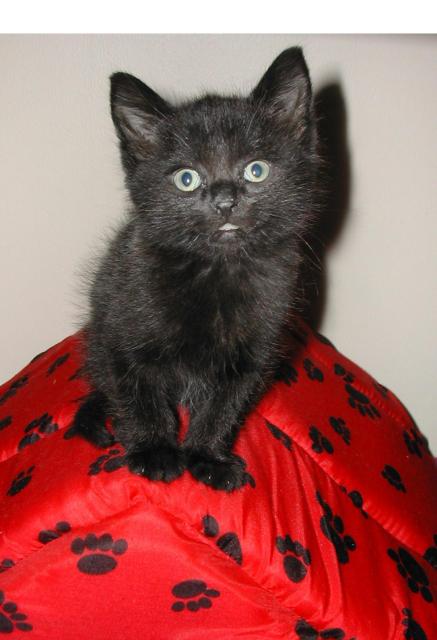QuestionQUESTION: Hi Ali. I take care of a colony of feral cats in my neighborhood. Recently, a new cat arrived, which isn't a new phenomenon. But, she comes up to my back sliding glass door, rubs on it, and meows, very much unlike the ferals. I am assuming she is stray and not feral, but she is skittish around people. She now comes up to my hand and will eat treats of it after putting in a little time. As it seems she's not feral, I'd like to bring her inside and find a good home for her or keep her myself with my other cats. I want to do this transition the right way, and in the way that's least traumatic for her. She's already spayed because her ear is tipped, but, other than that, I don't know much about her. I'm guessing she has no home since her ear is tipped, but I have no way to tell.
Any advice you have about whether I should move forward in transitioning her, and, if so, how I should best do that, would be very greatly appreciated!
Thank you very much,
Beth
ANSWER: Beth,
I'd like to start off by thanking you for the time/labor intensive volunteer work you put in caring for your local feral/stray cat population - too bad these cats don't have more people like us on their side, they certainly deserve better than they get most of the time. Based on your description of this kitty I'd have to say that I'm in total agreement with your hunch, this baby girl is NOT feral, she's a stray and it sounds like she's in need of plenty of TLC, some stability, patience, training (to trust people, live in a home environment, be comfortable with the daily routines of a household, etc) as well as plenty of time, affection and attention. It sounds to me like you've already gone ahead and started this kitty on the road to trusting you and being fairly comfortable with you. Getting this kitty to learn (or relearn) about an indoor environment, the sights, sounds, smells and activity that goes along with living inside is a tall order. It's important to be aware (and I'm sure you are) that this kitty is going to need a lot of work. It sounds to me like this precious kitty has been through a lot in her lifetime, unfortunately people with compassionate hearts for these cats tend to be few and far between. All too often abandoned pets and their feral offspring are subjected to acts of unbelievable cruelty, in some cases people want to avoid taking responsibility for these cats and they don't want them on their property and in a growing number of cases these cats are being tortured as part of gang initiations - apparently whoever does the cruelest thing wins a spot in the gang (pretty twisted as far as I'm concerned, it doesn't take a tough person to torture a vulnerable being that can't defend him/herself against such a formidable human opponent). What many people who have a problem with feral/stray cats being in their neighborhood seem to conveniently forget that there wouldn't be a problem with these cats if their human caregivers had taken time to decide if they were truly ready to adopt and made responsible, ethical decisions in terms of their cat's care. Strays are simply abandoned pets, feral cats are their offspring, the cat colonies are fairly preventable with responsible pet guardianship, proper care and basic husbandry. It's wonderful to know that you do care for these cats and you've clearly taken a significant amount of time, energy, money and resources to see that these cats receive the best care possible. Before I go into great detail about introducing this kitty to the indoors I'd like to ask you a few basic questions about this precious baby girl and your relationship with her. The more information I have the better since your information determines which solutions I'm able to offer you, clearly time is of the essence if you live in a temperate climate since winter is fast approaching so I'd like to help you out ASAP. The questions are as follows:
- Have you ever allowed this kitty into the house? If you have it becomes that much easier to bring her indoors. The simplest thing to do if she does come inside would be to confine your own resident cats briefly while you invite this kitty inside and gently close the door behind her. A food lure like tuna, sardines or salmon packed in water is often very effective - most cats love this stuff! Once kitty is indoors and you have the door closed then you can try to either lure her into a crate or see if she'll allow you to pick her up and take her to the room you have prepared for her. Make extra sure that you've washed any dish that your own cats eat/drink from if your newly rescued kitty has decided to help herself from the household dishes. DO NOT allow this kid to share food/water bowls, litter boxes or toys with your resident cats until she's been cleared by a vet and she's been kept confined in her safe room (confining fearful strays is also incredibly effective because they're not so overwhelmed - it allows you to break down the household for this kitty room by room so that she can become more comfortable.)
- Have you taken the time to prepare this little girl a room of her own? (You will want to do this to minimize the risk of spreading viral/bacterial infections from this kitty who you know very little about to your own resident cats AND gradual introductions are less likely to end in fireworks displays since cats are very territorial and not that fond of sudden changes in their environment)
- Will this kitty allow you to handle her with relatively little fuss?
- Have you exposed this kitty to anyone else (friends, family etc)?
- How long have you known this kitty?
- Will she eat in your presence (ie tuna, salmon sardines packed in water)?
- Does anyone in your area know where she came from? Sometimes neighbors can provide valuable insights into newly arrived "strays" that nobody seems to know, it's possible that she was recently left behind by someone moving out of the area...If this is the case I'd encourage you to get this kitty to a vet ASAP to be examined for any evidence of cruelty or neglect, if your vet finds something pass it on to the local humane law enforcement in your area so that charges can be pursued against this kitty's former caregiver.
If your kitty is super fearful and balks when you offer her a chance to come indoors you can try adding a homeopathic remedy called Bach's Rescue Remedy to her food for a few days then try again - the Rescue Remedy helps to calm and reassure. Once you've answered the above questions I'll be able to give you more detailed advice for this situation. If you have any further questions, concerns or you'd like me to clarify anything in this answer I'd be happy to help you out to the best of my ability.
---------- FOLLOW-UP ----------
QUESTION: Ali,
Thanks so much for your advice. The following is some more information related to your quesitons:
1. Question: Have you ever let the kitty in the house?
Answer: Yes. First, I seclude my other cats in other rooms. Then, I lure the stray kitty in the house with tuna, sardines, and cat treats. I have gotten to her to come all the way in the house, and started to implement your advice about trying to slowly close the door. She is very hesitant, and bolts before I can close the door all the way. But, she still comes back everyday and I try this exercise every day. She is making progress as she comes a little farther into the house every time.
2. Question: Have I prepared a room?
Answer: I have prepared a very large dog crate for her in a secluded room separate from the other cats, including her own litter box, food bowls, blankets, and new toys the other cats have not touched. I was thinking that once she gets used to this space, I could move her into a full room, still secluded from the cats? Is this the correct method?
3. Question: Will she allow me to handle her?
Answer: No. She has allowed both my boyfriend and I to pet her at times. But, she's never allowed us to pick her up, or even come close.
4. Question: Has she been exposed to anyone else?
Answer: The only people I have exposed her to is myself and my boyfriend.
5. Question: How long have I known her?
Answer: I've only known the kitty for about a month.
6. Question: Will she eat in my presence?
Answer: Yes, she seems pretty comfortable eating around me and my partner.
7. Question: Does anyone in your area know where she came from?
Answer: I am not sure, but am now checking into that.
Thank you so much for all of your advice!! I very much appreciate it!!!
Beth
AnswerBeth,
With regards to getting this kitty inside I think you're on the right track, but for this kitty it might be too much, too soon - she wants to stay with you, she just hasn't completely committed to the idea yet. It's absolutely perfect that you confine your own cats while this kitty comes in, it's in everyone's best interests since you don't know the vaccine history of this kitty and you don't want her or your resident cats to get any viral or bacterial infections. I realize that it's getting chilly outside, but another way you could help speed the process of getting this baby girl inside without frightening her would be to simply leave the door ajar while she's eating her extra special treats. If she feels that she can come and go freely without the threat of being confined then she's more likely to decide she wants to stay - she may even let you know she's ready to call your house home by stretching out on a piece of furniture or exploring the house beyond the room she's getting her treat in. The whole idea is to build her trust in you - it sounds like she's had a tough life and she's not really eager to trust people so allowing her to do things on her own schedule will make things easier for both of you (even though heating costs might initially rise a bit).
I do think that providing your stray foundling with a room of her own is best, a large dog crate isn't really going to allow her the freedom she'll need to become comfortable and feel safe in your home. She may have to be confined for longer than the average 2-3 weeks since she's such a fearful, anxious girl, but with time, patience and work she should be ready to become a full fledged member of the family after a relatively short period of time. I would recommend setting the room up with the food, water, kitty litter, bedding and toys once your kitty is ready to stay awhile. You could use the dog crate as kind of a kitty cave by covering it with a blanket and removing the door (so that she doesn't feel trapped in the event it accidentally closes on her) to create a cave or den like environment. Cats like to feel safe and protected, sometimes their primary defense is to hide in a dimly lit, quiet place until any perceived threat passes.
You'll want to be absolutely certain you provide this kitty with a couple of scratch posts/pads. Cats do not actually "sharpen" their claws, when they exercise their claws they're actually stretching their shoulder and back muscles, marking their scent as a means of communicating with other cats (kind of like an I was here, allow me to introduce myself message for other cats in the area) and it helps to alleviate stress and tension. I do not recommend declawing surgery for a variety of reasons but the most basic reasons are the fact that this is an extremely painful surgery for the cat, cats who have been declawed may be more likely to develop behavioral issues that include house soiling, intercat aggression and biting and the leading cause of death in North American cats is euthanasia secondary to behavioral issues. Many more cats are abused, abandoned or neglected as a direct result of behavioral problems. I can offer you a more complete explanation of the surgery, how the American Veterinary Medical Association (AVMA) stands on the issue and recommendations they've made as well as how the Humane Societies and SPCA shelters stand on declawing.
The fact that this kitty hasn't allowed you or anyone else that you know of close enough to her to pick her up or pet her may be an indication of a few scenarios. This kitty may have been abused or neglected by previous human "care"givers who were supposed to provide her with food, water, medical care, love, mental stimulation and creature comforts. It's also possible that this kitty is a stray that has become part of a horrifying pattern of animal abuse that's becoming popular - teens and young adults about to be initiated into gangs are being challenged to abuse or torture stray cats, dogs and even pet cats and dogs allowed outside unsupervised - this may be how she lost her trust in people even though she still recognizes that they're able to provide food and comforts she can't get on her own (ie a warm place to hang out, really good food, etc). My recommendation at this point is that you don't force the issue of physical contact. Allowing a cat that's showing clear signs of anxiety or fear (regardless of the reasons) to come to you is the best thing for everyone. Ultimately spending time with this kitty and giving her the time and space she needs to learn how to trust you will be difficult at times, but trust me, it's the most amazing feeling when a kitty who was terrified makes that first move to initiate contact with you. Once this kitty does decide she's going to make your house her permanent home then you'll need to spend as much time as possible with her. Ideally you and your partner will make time each day to spend separately with this little girl in her safe room. Ideally you'll want to avoid eye contact, touching this kitty or even speaking to her - for a fearful animal the extra stimuli aren't helpful and can actually increase anxiety. I've found that spend as much time as possible as often as possible with a fearful kitty while I do some other quiet activity to occupy my time works well - as much as cats can be very fearful and flighty by nature they're also very curious and there will come a point where curiousity outweighs fear and this kitty will come to you and ask for attention. When this happens you will absolutely have to avoid jumping up and cheering (I know you'll want to, I want to dance around yelling with absolute joy every time I help a fearful cat get his/her life back). In general it's easier to spend time quietly sitting on the floor in cat's safe room (be sure you choose an area off to the side away from her food, water, litter, bed, hiding places, toys, etc) if you bring something to do that will mean your attention is focused elsewhere. Tasks like catching up on emails (on a laptop), paying bills online, reading a book, doing word searches, crossword puzzles, suduko problems, brain teasers on paper (essentially whatever you can do to occupy your attention so that you aren't giving eye contact, speaking with her or feeling tempted to touch her before she's ready to accept your attention) are best.
Once kitty seems comfortable seeking out and accepting general handling and affection from you and your partner then you can work towards improving her confidence even more by teaching her how to play. Believe it or not play isn't entirely instinctive - cats need to be in an environment where they're safe, well fed, healthy and well cared for in order to allow them the luxury of play for the sake of play. What this means is that cats who have had difficult living situations for the first 12 weeks or so of life may have difficulty with the concept of playing for the sheer joy of it, during the rehabilitation process I try to go back to basics and teach cats and kittens to enjoy life a little, play normally and relax. Playtime is very important because it not only helps to hone basic feline life skills, but it helps kitties to burn off excess energy and anxiety.
Since I nearly lost my eldest cat during the Menu Foods pet food recalls of 2007 I've done massive amounts of research on feline nutrition, the pet food industry and what the best possible options are in terms of providing the highest quality, most species appropriate diet for my cats. I realize that you didn't contact me regarding nutrition, but I can tell that you love your cats very much and want only the best for them so I've taken the liberty of including some information on nutrition. In the interest of providing the best possible nutrition for all of your house cats I'd strongly suggest that you check out the following websites:
- http://www.halopets.com/pet-education/pet-articles/pet-food-what-you-need-to-kno
- www.catinfo.org
- www.catnutrition.org
- www.felinespride.com
These websites contain information that I believe to be accurate, honest and down to earth enough that laypeople such as ourselves can actually understand the bare bones of it all. I know that you take time out of your day to care for a feral colony and doing my share of feeding stray/feral cats I understand that the main priority is to fill hungry bellies so that these kitties can go on to live another day. Some of the information provided above regarding nutrition just isn't feasible in terms of cost when it comes to feeding a feral colony, however most ferals and long time strays will supplement whatever diet they're being fed with the occasional rodent or bird. I do my best to feed my resident cats the best possible diet that I can afford simply because feeding the cheaper foods isn't really a bargain when you factor in the fact that cats being fed diets that don't fulfill their unique nutritional needs will most likely lead to more health problems. Essentially what you'd save on lower quality discount foods would most likely cost you in a vet's office and most pet parents want to try and avoid having expensive veterinary bills for preventable illnesses.
The way to a cat's heart is pretty similar to the way to a man's heart - yummy treats that are super tempting tend to be amazingly helpful tools during the rehabilitation process for fearful kitties. There's a huge range of things you can give this kitty as treats and in my experience I've found it's best to try and mix things up a bit since cats are just like us - they get bored with getting the same thing over and over again, many cats will refuse a specific food if it's fed too frequently when it comes to treats. The following is a list of foods that you might want to try with this baby girl as you work with her:
~ Meat/broth baby foods in chicken, turkey, beef, lamb flavors are generally popular. Remember to avoid any baby foods that contain onions or garlic since they're not good for cats. Any brand name meat baby food is perfect for kitty treats, but I generally use a brand called Mother Hen, it's fresh frozen pureed meat and a box contains 6 little plastic containers. I prefer this brand over many others because the meat is fresher, it's frozen not preserved to be shelf stable, the meats are higher quality cuts. Another plus with this brand is the fact that you can microwave the containers provided that you take the foil lid off of them.
~ Most kinds of fish are well received by cats. The most popular favorites in our household over the years have been canned salmon, sardines, tuna, or mackeral packed in water. You could also purchase salmon fillets or steaks on sale and freeze them until they're need, they can be served raw or cooked provided that they've been deboned and you've cut the fish into small pieces. Don't give your kitty any kind of white fish raw, it's not good for cats and if given in large enough amounts or frequently enough these types of fish can cause serious health problems. Canned cocktail shrimp or freshly cooked shrimp are considered extra special treats by some cats. Our own cats actually like lobster, crab and scallops, but since we're not able to fulfill the every whim and fantasy of our cats these are extra special treats that they get once in awhile.
~ Chopped raw/cooked chicken or turkey breast is usually popular. If you plan to serve any meat or poultry raw be sure that it's fresh and I try to go organic whenever possible since it's more nutritious. Some cats will enjoy the more gamey taste of meats like caribou, venison, bison, duck or goose raw or cooked, just be sure that you don't give your kitties any raw liver and it's best for them not to receive liver in large quantities or often.
~ Some cats have a craving for dairy, the best way to indulge that is to give them a tablespoon or two of unsweetened, organic plain yogurt. Most other products made from cow's milk have the potential to cause vomiting, diarrea and discomfort since cats generally become lactose intolerant around the three month mark. The reason that lactose intolerance isn't an issue with yogurt is because it contains beneficial bacteria that digest the lactose which is why it works well to help replenish beneficial bacteria in the digestive tract in cats that have been vomiting, are on antibiotics or they have diarrea for any other reason because yogurt helps to replenish bacteria in the digestive tract that can be wiped out during a course of antibiotics or a bout of diarrea. One abused, severely traumatized kitten that I worked hard to rehabilitate suddenly forgot his extreme fear of people and surprised us both by decided to bond with me immediately when I held a piece of Kentucky Fried Chicken under his nose while he slept under my bed. After that he never looked back and I was able to place him with a loving new forever family.
At the moment since this little girl appears to be fairly fearful and anxious I think it's best to avoid introducing her to any other people in your life - for now she's become familiar with you and your partner, that's all that she needs at the moment. You don't want to overburden a fearful kitty because while you have the best of intentions in terms of loving her, providing for her and giving her the best possible life she doesn't know that - all she knows at this point is that you a two legged furless creature that's 10 times her size and for some reason she's absolutely terrified of people. Once your kitty is calm, comfortable in her environment, socialized with the other cats, vet checked, vaccinated, etc then you can begin slowly introducing her to friends one person at a time. I'd recommend avoiding situations where she's got to deal with learning about several new people at once since she's clearly got a reason for being as cautious and fearful around people as she's become. No cat is born as fearful as you describe, something traumatic happened to this little girl to make her as fearful as she is, but based on your description I'm really not inclined to think that she's a kitty who was born feral, I suspect she was an abandoned pet. Abandonment in and of itself could potentially create a fearful kitty if your girl hasn't been abused - imagine living life in a home where food, water and cozy places to sleep (at a bare minimum) were provided then suddenly finding yourself outside in an unfamiliar environment where there's loud noises, no bowl of food/clean water, no cozy places to sleep and no human to take care of your basic needs....I'm pretty sure it would be a terrifying experience to have your life change drastically in an instant.
In a month of caring for this little girl it sounds to me like she's made some incredible strides, the fact that she's able to eat in front of you and your partner comfortably is a positive sign, she's learning to trust you both a little at a time. All you need to do is to help her keep building on that trust and you'll soon have her living comfortably in your home. She's going to need loads of love and work and to be completely honest after pouring your heart and soul into a kitty like this I'm not sure you'll want to find her a new home, but if you do decide that one more is too many then I'd strongly suggest helping this kitty out by slowly introducing her to her new caregiver over an extended period of time to avoid having her regress behaviorally. I'm certainly willing to offer any help or support that you might need during this process, so please, don't be afraid to contact me anytime and I'll do my absolute best to help you out. If there's anything that you'd like me to clarify or you have any other questions or concerns I'd be happy to help you out.

 Cat in Heat with a little blood in her stool
Question
Millie Moo
Hi, I have a 5 month old female kit
Cat in Heat with a little blood in her stool
Question
Millie Moo
Hi, I have a 5 month old female kit
 kittens nails
QuestionQUESTION: Hi Pati,
Its me again Xris. I seek y
kittens nails
QuestionQUESTION: Hi Pati,
Its me again Xris. I seek y
 Please help
Questionmy cat
QUESTION: Hi,
I have a Ragdoll ca
Please help
Questionmy cat
QUESTION: Hi,
I have a Ragdoll ca
 18 year old cat has blood clots in urine
Question
Tucker
My 18 year old male neutered cat is hyp
18 year old cat has blood clots in urine
Question
Tucker
My 18 year old male neutered cat is hyp
 Cats Fighting
Question
Big Cat
Hello.i have a cat named lucky.he is a
Cats Fighting
Question
Big Cat
Hello.i have a cat named lucky.he is a